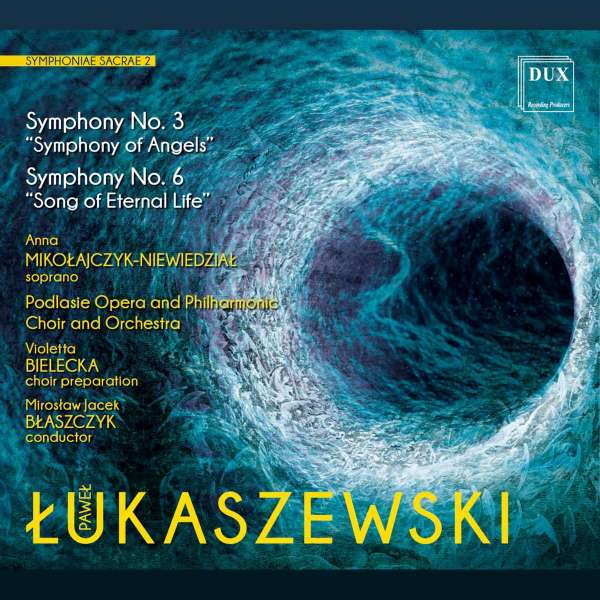Pawel Lukaszewskis Dritte Symphonie entfaltet sofort mit einem jenseitig wirkenden Klanggemisch einen strengen Sog auf den Hörer. Zum sehr leisen Teppich aus Qigongkugeln, Harfe und Celesta gesellt sich der ebenso leise wispernde Chor, der in extrem langsamem Zeitmaß singt. In diese Stimmung gebracht, entwickelt sich die Symphonie der Engel, vom Komponisten selber auch Lied der Engel genannt, in zwei Sätzen. Mit dieser religiösen Konnotation, unterlegt mit Kirchenschriften und apokryphen Texten zum Leben der Schutzengel mag man musikalische Nähe bei Gorecki, Messiaen oder Pärt verorten.
Die Sechste Symphonie beschäftigt sich mit herausragenden künstlerischen Leistungen früherer Zeiten. Vom Komponisten als Triptychon bezeichnet, könnte man sie auch als Sinfonie in einem Satz ansehen, der ein klingendes Vor- und Nachwort von jeweils weniger als einer Minute beigegeben ist. Ihr Mittelsatz lässt auch deutlich konturierte rhythmisch prägnante Anteile hören. Im Nachwort entwickelt sich noch mal ein Ausbruch an Intensität.
Chor und Orchester aus Bialystok sowie die Sopranistin Anna Mikoajczyk-Niewiedzial widmen sich unter dem Dirigat von Miroslaw Jacek Blaszcyk diesen beiden Werken mit Hingabe und machen so die Intentionen des Komponisten sehr deutlich. Insbesondere die Erfassung und Ausformung der emotionalen Seite der Musik gelingt den Interpreten. Dabei wird mitgesagt, dass die instrumentale Realisierung ebenfalls keine Wünsche offen lässt. Der von Violetta Bielecka einstudierte Chor kann dabei gerade auch in den ganz zarten Partien mit großer Homogenität und Sicherheit überzeugen. Anna Mikoajczyk-Niewiedzial fügt ihre warm temperierte Stimme dezent leuchtend mit Emphase in den Gesamtklang.
Mag auch die Dritte Symphonie dank ihrer stimmungsstarken Elemente noch mehr gefallen, so sind doch beide Werke eine weitere wichtige und geeignete Stufe, der Bekanntheit des Komponisten Pawel Lukaszewski zu dienen.
Pawel Lukaszewski’s Third Symphony immediately unfolds an austere pull on the listener with an otherworldly sound. The very quiet carpet of qigong balls, harp and celesta is joined by the equally quietly whispering choir, which sings in extremely slow time. Set in this mood, the Symphony of Angels, also called Song of the Angels by the composer himself, develops in two movements. With this religious connotation, underlaid with church scriptures and apocryphal texts on the life of the guardian angels, one might locate musical proximity with Gorecki, Messiaen or Pärt.
The Sixth Symphony deals with outstanding artistic achievements of earlier times. Described by the composer as a triptych, it could also be considered a symphony in one movement, with a resonant preface and epilogue of less than a minute each. Its middle movement also allows clearly contoured rhythmically concise parts to be heard. In the epilogue, a burst of intensity develops once again.
The choir and orchestra from Bialystok, as well as the soprano Anna Mikoajczyk-Niewiedzial, under the baton of Miroslaw Jacek Blaszcyk, devote themselves to these two works with dedication, making the composer’s intentions very clear. In particular, the performers succeed in capturing and shaping the emotional side of the music. It is also said that the instrumental realization also leaves nothing to be desired. The chorus, rehearsed by Violetta Bielecka, can convince with great homogeneity and assurance, especially in the very tender parts. Anna Mikoajczyk-Niewiedzial adds her warm voice discreetly shining with emphasis to the overall sound.
Even if the Third Symphony may be even more pleasing thanks to its atmospheric elements, both works are another important and suitable step to serve the awareness of the composer Pawel Lukaszewski.


















